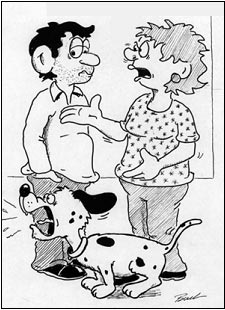|
Need Help?
|
|
Call
1-800-372-3706
to
speak to a Veterinary Behavior Technician |
|
Paws To Speak!
Member
Main Menu
|

Library Links
Bark
Interruption Menu
Barking in the Vet Lobby
Close Tethering
Watch
Video
Helpful
Teaching Tools

Pet Professional Tips
Make
sure dogs have access to water.
Ask "barkers" to
sit, then take them out to rule out the need to
eliminate.
Identify "lead barkers" and isolate them,
if possible.
Provide dogs with something to do such as food puzzles or kongs stuffed with frozen
dog food.
Have an authorization on file to
give mild sedation, as a last result to comfort and
calm the excessive barking.
Gentle Leaders are helpful to correct excessive barking.

|
 |
|
Help is at your
fingertips by library, email and
phone. |

Click on
Library Icon
to learn more
|
How to Prevent and Respond to Excessive Barking
Introduction
Barking is a normal
and natural means of canine communication. However,
when barking becomes excessive it can become a
source of frustration to families and neighbors. How
much your dog barks falls under establishing your
house rules.
Barking
may be desirable when the dog is guarding the home
or warning strangers at the door. The most important
principle in preventing excessive barking is to
interrupt any non-approved barking episodes
before they become extended.
|
Consider a 5-Bark
Rule: Up to 5 barks is
okay and then it must be
interrupted.
Prevent
excess barking from becoming
a bad habit.
|
Unintentional reinforcement
of excess barking
- Be careful not to accidentally
reinforce unwanted barking.
- Do
NOT attempt to stop barking or
calm the dog by providing a
bone, toy, food treat, or with
your attention.
- Do not pet
the dog while the dog is still
barking.
- Do NOT let the dog in
the house or release from any
other isolation or confinement
in response to barking.
- Provide
distractions before the barking
begins or as a reward for the
dog being quiet on your request.
- Make sure the dog is quiet -
even for two seconds - before
getting any rewards.
- As
time goes on, expect more and
more seconds, then minutes of
quiet before the reward.
It can also happen when a dog is
released from confinement after
barking. Be aware if there are
other things you may be doing to
unintentionally reinforce the
barking you wish to stop.
 Teaching the "quiet" Instruction Teaching the "quiet" Instruction
Dogs
should be trained to stop barking after being asked
to be, "quiet." To teach the dog the word,
"quiet" begin to praise the dog when he or she is
quiet right before a situation that usually triggers barking.
Step
One - After you are sure the dog does
not need to eliminate, give a stern "Quiet",
then praise for being quiet.
Step Two
- If step one is not effective, or if the
whining is repeated later, apply a head collar.
Step Three
- Using a head collar, like the Gentle
Leader, attach a long leash. Give a tug on the end of
the leash immediately when the dog begins to
make a noise. Wait 3 seconds. Praise the dog for
being quiet. If the whining continues, follow
the time intervals given above. If the dog is in
a kennel, and you have not been successful
interrupting the vocalization, try a rap on top
of the kennel just to startle the dog so that
the barking is interrupted, then praise quiet.
Step Four
-
Move kennel or tether
the dog in different parts of the house.
Provide a chew to give your dog a good
alternative to barking.
If
none of these four steps are working, consider a
Pet Behavior History Analysis.
You and your dog need professional help.
Something isn't right.
Get lab work to rule out early diabetes or renal
disease. If the dog is healthy, then you may
want to remove food and water earlier in the
evening, and increase the reward for late (just
before bed) elimination.
Teaching this
human vocabulary word takes
effort. Just like toilet
training a toddler, you need to
be consistent.
Do not allow
excessive barking. Barking is a
stress release and easily
becomes a habit. It is
important when teaching the dog
to be quiet and for any other
training that the dog is walked
at least once daily for at least
20 minutes and preferably
longer.
At home, when the dog begins
barking, go to where the dog is,
move in front of the dog so you
take over the leader position,
and determine why the dog is
barking. See if there is a
stranger outside of the house or not. If
your dog is barking at neighbors
across the street or a neighbor dog or cat, then relax YOUR body (as a
calming signal). Then, face the
dog, and say in a very relaxed
voice, it's nothing, be
"quiet."
During this training
time, it can be helpful to have the dog wearing a
head collar
and dragging a leash indoors. Do not grab the dog by
the collar. Use the leash-collar combination to
gently pull the dog's mouth closed as you give the
quiet Instruction.

|